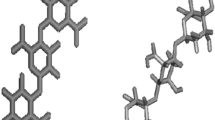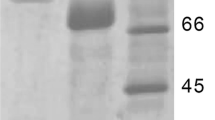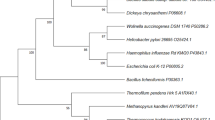Abstract
Pullulanase type I (PulA) is a debranching enzyme that specifically cleaves α-1,6-glycosidic linkages in pullulan. Pullulan has not only diverse applications in food industry but also has immune-stimulatory effects on B and T cells, and found to enhance the production of various anti-inflammatory cytokines in human. Moreover, pullulan has been suggested as a possible anti-cancer drug delivery agent without adjuvant due to its unique structure. The process of pullulan degradation is unresolved due to imprecise pullulanase structural characteristics. Therefore, the present study aimed to understand the structural and functional characteristics of pullulanase enzyme from Geobacillus thermopakistaniensis MAS1 strain using various computational approaches. The physio-chemical topographies and secondary structure of GT_PulA were explored using ProPram, InterPro and SMART. Various tools like I-TASSER, ModRefiner, RAMPAGE, PROCHECK and MOE 2009.10 were used to construct and verify the 3D structural model. The structural elucidation confirmed the significant domains, i.e., CBM48, CBM2, and TIM barrel having catalytically active residues, and conserved region YNGWDP. CBM2 domain along with TIM barrel has a capacity to bind different ligands and proved favorable for multiple substrate catalyses. These structural properties can have a potential effect on enhancing enzymatic activity of GT_PulA enzyme.







Similar content being viewed by others
Abbreviations
- GT_PulA:
-
Geobacillus thermopakistaniensis Pullulanase type 1
References
Van Der Maarel, M. J., Van Der Veen, B., Uitdehaag, J. C., Leemhuis, H., & Dijkhuizen, L. (2002). Properties and applications of starch-converting enzymes of the α-amylase family. Journal of Biotechnology,94, 137–155.
Han, T., Zeng, F., Li, Z., Liu, L., Wei, M., Guan, Q., et al. (2013). Biochemical characterization of a recombinant pullulanase from thermococcus kodakarensis kod1. Letters in Applied Microbiology,57, 336–343.
Kunamneni, A., & Singh, S. (2005). Response surface optimization of enzymatic hydrolysis of maize starch for higher glucose production. Biochemical Engineering Journal,27, 179–190.
Nagatomo, D., Taniai, M., Ariyasu, H., Taniguchi, M., Aga, M., Ariyasu, T., et al. (2015). Cholesteryl pullulan encapsulated tnf-alpha nanoparticles are an effective mucosal vaccine adjuvant against influenza virus. Biomedical Research International,25, 15.
Uenaka, A., Wada, H., Isobe, M., Saika, T., Tsuji, K., Sato, E., et al. (2007). T cell immunomonitoring and tumor responses in patients immunized with a complex of cholesterol-bearing hydrophobized pullulan (chp) and ny-eso-1 protein. Cancer Immunology,7, 9.
Nochi, T., Yuki, Y., Takahashi, H., Sawada, S., Mejima, M., Kohda, T., et al. (2010). Nanogel antigenic protein-delivery system for adjuvant-free intranasal vaccines. Natural Matererials,9, 572–578.
Haki, G., & Rakshit, S. (2003). Developments in industrially important thermostable enzymes: A review. Bioresource Technology,89, 17–34.
Gupta, R., Gigras, P., Mohapatra, H., Goswami, V. K., & Chauhan, B. (2003). Microbial α-amylases: A biotechnological perspective. Process Biochemistry,38, 1599–1616.
Siddiqui, M. A., Rashid, N., Ayyampalayam, S., & Whitman, W. B. (2014). Draft genome sequence of geobacillus thermopakistaniensis strain mas1. Genome Announcements,2, e00559–e514.
Bertolini, A. C. (2010). Starches: Characterization, properties, and applications. Boca Raton: Taylor & Francis.
Souza, P. M. (2010). Application of microbial α-amylase in industry—A review. Brazilian Journal of Microbiology,41, 850–861.
Bertoldo, C., & Antranikian, G. (2002). Starch-hydrolyzing enzymes from thermophilic archaea and bacteria. Current Opinion in Chemical Biology,6, 151–160.
Janeček, Š. (2002). How many conserved sequence regions are there in the α-amylase family. Biologia,57, 29–41.
Lombard, V., Golaconda Ramulu, H., Drula, E., Coutinho, P. M., & Henrissat, B. (2013). The carbohydrate-active enzymes database (cazy) in 2013. Nucleic Acids Research,42, D490–D495.
Domań-Pytka, M., & Bardowski, J. (2004). Pullulan degrading enzymes of bacterial origin. Critical Reviews in Microbiology,30, 107–121.
Singh, R. S., Saini, G. K., & Kennedy, J. F. (2008). Pullulan: Microbial sources, production and applications. Carbohydrate Polymers,73, 515–531.
Rashid, N., Farooq, A., & Akhtar, M. (2009). Insoluble but enzymatically active α-amylase from bacillus licheniformis. Biologia,64, 660–663.
Armenta, S., Moreno-Mendieta, S., Sánchez-Cuapio, Z., Sánchez, S., & Rodríguez-Sanoja, R. (2017). Advances in molecular engineering of carbohydrate-binding modules. Proteins: Structure, Function, and Bioinformatics,85, 1602–1617.
Hii, S. L., Tan, J. S., Ling, T. C., & Ariff, A. B. (2012). Pullulanase: Role in starch hydrolysis and potential industrial applications. Enzyme Research. https://doi.org/10.1155/2012/921362.
Niehaus, F., Peters, A., Groudieva, T., & Antranikian, G. (2000). Cloning, expression and biochemical characterisation of a unique thermostable pullulan-hydrolysing enzyme from the hyperthermophilic archaeon thermococcus aggregans. FEMS Microbiology Letters,190, 223–229.
Ryan, S. M., Fitzgerald, G. F., & van Sinderen, D. (2006). Screening for and identification of starch-, amylopectin-, and pullulan-degrading activities in bifidobacterial strains. Applied and Environmental Microbiology,72, 5289–5296.
Antranikian, G., Vorgias, C. E., & Bertoldo, C. (2005). Extreme environments as a resource for microorganisms and novel biocatalysts. Marine Biotechnology,96, 219–262.
Sterner, R. H., & Liebl, W. (2001). Thermophilic adaptation of proteins. Critical Reviews in Biochemistry and Molecular Biology,36, 39–106.
Malakar, R., Tiwari, A. & Malviya, S. (2010). Pullulanase: A potential enzyme for industrial application. International Journal of Biomedical Research. https://doi.org/10.7439/ijbr.v1i2.53
Talukdar, S., Bayan, U., & Saikia, K. K. (2017). In silico identification of vaccine candidates against klebsiella oxytoca. Computational Biology and Chemistry,69, 48–54.
Mikami, B., Iwamoto, H., Malle, D., Yoon, H.-J., Demirkan-Sarikaya, E., Mezaki, Y., et al. (2006). Crystal structure of pullulanase: Evidence for parallel binding of oligosaccharides in the active site. Journal of Molecular Biology,359, 690–707.
Malle, D., Itoh, T., Hashimoto, W., Murata, K., Utsumi, S., & Mikami, B. (2006). Overexpression, purification and preliminary X-ray analysis of pullulanase from bacillus subtilis strain 168. Acta Crystallographica Section F: Structural Biology and Crystallization Communications,62, 381–384.
Turkenburg, J. P., Brzozowski, A. M., Svendsen, A., Borchert, T. V., Davies, G. J., & Wilson, K. S. (2009). Structure of a pullulanase from bacillus acidopullulyticus. Proteins: Structure, Function, and Bioinformatics,76, 516–519.
Gourlay, L. J., Santi, I., Pezzicoli, A., Grandi, G., Soriani, M., & Bolognesi, M. (2009). Group b streptococcus pullulanase crystal structures in the context of a novel strategy for vaccine development. Journal of Bacteriology,191, 3544–3552.
Siddiqui, M. A., Rashid, N., Ayyampalayam, S., & Whitman, W. B. (2014). Draft genome sequence of geobacillus thermopakistaniensis strain mas1. Genome Announce,2, e00559–e514.
Amin, A., Ahmed, I., Salam, N., Kim, Y. B., Singh, D., Zhi, Y. X., et al. (2017). Diversity and distribution of thermophilic bacteria in hot springs of pakistan. Microbial Ecology,74, 116–127.
Meekins, D. A., Vander Kooi, C. W., & Gentry, M. S. (2016). Structural mechanisms of plant glucan phosphatases in starch metabolism. The FEBS Journal,283, 2427–2447.
Janeček, Š., Majzlová, K., Svensson, B., & MacGregor, E. (2017). The starch-binding domain family cbm41—An in silico analysis of evolutionary relationships. Proteins: Structure, Function, and Bioinformatics,85, 1480–1492.
Xu, J., Ren, F., Huang, C. H., Zheng, Y., Zhen, J., Sun, H., et al. (2014). Functional and structural studies of pullulanase from anoxybacillus sp. Lm18-11. Proteins: Structure, Function, and Bioinformatics,82, 1685–1693.
MacGregor, E. A. (2005). An overview of clan gh-h and distantly related families. Biologia,60, 5–12.
Machovič, M., Svensson, B., Ann MacGregor, E., & Janeček, Š. (2005). A new clan of cbm families based on bioinformatics of starch-binding domains from families cbm20 and cbm21. The FEBS Journal,272, 5497–5513.
Botha, J., Mizrachi, E., Myburg, A. A., & Cowan, D. A. (2017). Carbohydrate active enzyme domains from extreme thermophiles: Components of a modular toolbox for lignocellulose degradation. Extremophiles,22, 1–12.
Ali, R. & Shafiq, M. I. (2015). Sequence, structure, and binding analysis of cyclodextrinase (tk1770) from t. Kodakarensis (kod1) using an in silico approach. Archaea. https://doi.org/10.1155/2015/179196.
Yang, J., Yan, R., Roy, A., Xu, D., Poisson, J., & Zhang, Y. (2015). The i-tasser suite: Protein structure and function prediction. Nature Methods,12, 7–8.
Singh, C., & Atri, N. (2013). Chemo-informatic design of antibiotic geldenamycin analogs to target stress proteins hsp90 of pathogenic protozoan parasites. Bioinformation,9, 329.
Bateman, A., Birney, E., Cerruti, L., Durbin, R., Etwiller, L., Eddy, S. R., et al. (2002). The pfam protein families database. Nucleic Acids Research,30, 276–280.
Gopalakrishnan, K., Sowmiya, G., Sheik, S. & Sekar, K. (2007). Ramachandran plot on the web (2.0). Protein and Peptide Letters, 14, 669–671.
Rahmatabadi, S. S., Sadeghian, I., Nezafat, N., Negahdaripour, M., Hajighahramani, N., Hemmati, S., et al. (2017). In silico investigation of pullulanase enzymes from various bacillus species. Current Proteomics,14, 175–185.
Guillén, D., Sánchez, S., & Rodríguez-Sanoja, R. (2010). Carbohydrate-binding domains: Multiplicity of biological roles. Applied Microbiology and Biotechnology,85, 1241–1249.
Mohapatra, S., Prasad, A., Haque, F., Ray, S., De, B., & Ray, S. S. (2015). In silico investigation of black tea components on α-amylase, α-glucosidase and lipase. Journal of Applied Pharmaceutical Science,5, 42–47.
Zhao, Y., Chi, Z., Xu, Y., Shi, N., Chi, Z., & Liu, G. (2018). High-level extracellular expression of κ-carrageenase in brevibacillus choshinensis for the production of a series of κ-carrageenan oligosaccharides. Process Biochemistry,64, 83–92.
Simpson, P. J., Xie, H., Bolam, D. N., Gilbert, H. J., & Williamson, M. P. (2000). The structural basis for the ligand specificity of family 2 carbohydrate-binding modules. Journal of Biological Chemistry,275, 41137–41142.
Funding
The funding for this manuscript was provided by HEC, Pakistan.
Author information
Authors and Affiliations
Corresponding authors
Ethics declarations
Conflict of interest
All the authors declare that they have no any kind of competing interests.
Additional information
Publisher's Note
Springer Nature remains neutral with regard to jurisdictional claims in published maps and institutional affiliations.
Rights and permissions
About this article
Cite this article
Iqrar, U., Javaid, H., Ashraf, N. et al. Structural and Functional Analysis of Pullulanase Type 1 (PulA) from Geobacillus thermopakistaniensis. Mol Biotechnol 62, 370–379 (2020). https://doi.org/10.1007/s12033-020-00255-x
Published:
Issue Date:
DOI: https://doi.org/10.1007/s12033-020-00255-x




